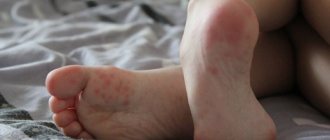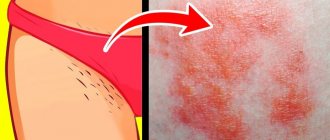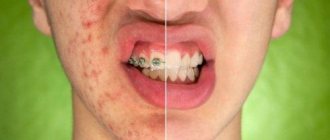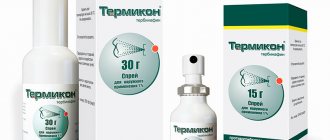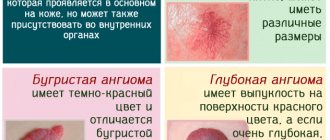Causes of diaper rash
As follows from the very definition of “diaper rash,” the cause of this disease lies in skin irritation from various infections. The folds of the skin, where it is always warm and humid, create ideal conditions for the growth of bacteria. The bacteria themselves enter the skin along with sweat and oily skin secretions. Urine, discharge from fistulas and hemorrhoidal cones, when they come into contact with healthy skin, begin to actively multiply, and we observe a picture of redness, peeling, and erosion of the skin surface. In hot weather, diaper rash occurs more often than usual. Obese people with a large number of fat folds are especially susceptible to this disease. In infants, diaper rash occurs due to lack of proper care and hygiene. It happens that diaper rash occurs due to an allergic reaction to some food or cosmetic product. To accurately identify the cause of allergic diaper rash, an examination by specialists will be required.
Skin nuances in the elderly.
The skin loses its elastic qualities due to a decrease in the amount of hyaluronic acid and collagen produced, resulting in dermatosis. Due to the lack of these chemical compounds in the body, the skin becomes thinner and drier. Due to such physiological disorders, the skin is much more susceptible to friction. Intertriginous dermatitis can also have the following causes:
- Impaired functions of the adrenal glands and kidneys.
- Vegetative-vascular type of dystonia;
- Deviations in the functioning of the thyroid gland.
- Diabetes.
Skin cells in older people regenerate much more slowly due to loss of elasticity and physiological changes that are inevitable with natural aging. Therefore, dermatitis cannot be treated negligently; it must be treated. Women often suffer from dermatitis that appears under the mammary glands, this occurs due to changes in hormonal levels and high sweating.
Also, this disease can often manifest itself near the genitals. Older people do not always control the process of urination. In men, these signs can occur in the groin area, the reasons for this being that this area of the body is most susceptible to friction.
People who are overweight or bedridden are much more susceptible to this disease. The body of an obese person produces an excessive amount of subcutaneous fat.
Symptoms
They are accompanied by redness of the skin, severe itching, and pain. Most often they are found in the groin, on the buttocks, in the lower abdomen, in the armpits, in any folds of our skin.
There are three degrees of the disease:
Lung
It is characterized by slight redness, while the skin is not damaged, there is only a slight swelling.
Average
Here, along with severe redness, obvious mechanical damage is visible on the skin.
Heavy
Greater degree of skin damage, bright red color, formation of ulcers. The primary manifestation of diaper rash always begins with redness of areas of the skin - erythema, which gradually spreads to healthy areas. In severe forms, diaper rash is accompanied by infections. Streptococci and fungi are the most common of them.
Diagnostics: how to distinguish diaper rash from other diseases
The main diagnostic method is a routine visual examination of the patient. If it is a child, then it is examined by a pediatrician in the hospital. Diaper rash in adults is treated by a dermatologist.
If an advanced stage has been identified, which is accompanied by certain complications, the doctor may prescribe tests in the form of culture or scraping. The third degree of diaper rash can easily be confused with other diseases, especially in children. It could be dermatitis or a fungal infection. Therefore, it is necessary to know how to distinguish inflammation from other diseases.
For diaper rash:
- Inflammation appears in the folds of the skin or where it comes into contact with clothing or diapers. If this is an allergy, then it can manifest itself in other areas - face, chest, stomach, back;
- The initial stage is characterized by slight redness, which quickly disappears with proper care. In more severe diseases, redness will not go away without special treatment with ointments or medications;
- The area on the skin affected by diaper rash does not have clearly defined boundaries. In infectious diseases they may look different. For example, if it is lichen, then the affected area will have clear and prominent contours, which are characterized by lighter areas in the center;
- Diaper rash of the first or second stage does not bleed and does not have the characteristic nodules and rash that appears with allergic dermatitis.
- Inflammations without complications of microbial eczema occur without an increase in body temperature, unlike infant roseola and rubella, with which they can be confused.
You need to be as careful as possible about your health and the health of your loved ones. Therefore, if any symptoms of the disease appear, even the most minor ones, it is better to go to the clinic for diagnosis by a professional specialist. It is not recommended to engage in self-diagnosis and self-medication, as you can only aggravate the situation or waste precious time that should be spent on proper treatment of diaper rash.
Treatment
In the initial stage of the disease, it is enough to remove the causes of its appearance. It is necessary to frequently and thoroughly wash all folds of the skin with warm water, a pink solution of potassium permanganate, and special antiseptic agents. After washing, be sure to thoroughly blot with a cotton cloth until completely dry, powder with talcum powder or use baby cream, zinc ointment, or any drying creams and ointments. It is necessary to ensure free access of air to the sore areas; if necessary, gauze pads can be attached to them. For moderate severity of diaper rash, lotions and compresses are effective. Therapeutic baths based on medicinal herbs are very helpful in the fight against diaper rash. In addition to the purely therapeutic effect, they provide an opportunity to rest and relax, and have a beneficial effect on the human body as a whole.
Pathogenesis
In the development of diaper rash, increased sweating and friction of the skin, which cause inflammation, are of primary importance. In addition, a higher temperature is created in closed folds of the skin compared to open and ventilated areas of the body. Accumulation of sweat and friction under elevated temperature conditions increase maceration (damage) of the skin. Fungi and bacteria contained on the skin actively multiply and lead to the development of skin infections. A decrease in skin protective factors and the presence of damage create conditions for pathogens to penetrate into the deep layers of the epidermis. Thus, dermatophytes (a type of fungus) have a keratolytic effect - they destroy the keratin of the stratum corneum, causing a pronounced and long-lasting inflammatory process.
Prevention of diaper rash in children
The child's bed linen and clothing should only be made from natural cotton fabrics, clean and ironed with a hot iron for disinfection. The baby must not be wet; for this, diapers should be changed as soon as they become wet. If diapers are used, it is important to pay attention to their quality and size - no hard or rubbing parts are allowed. After bathing, be sure to dry the child’s body well with a soft cotton towel and blot all skin folds. It is better to powder problem areas of the skin with special baby powders or lubricate them with boiled vegetable oil. Air baths are very important for a child, preferably several times a day. In order to eliminate the allergic nature of diaper rash in a baby, you need to use only special products for baby clothes when washing; no ordinary powders are strictly allowed for these purposes.
Classification
Diaper rash occurs along the way:
- Spicy.
- Recurrent (constantly renewed).
- Chronic (lasts more than 1.5 months).
- Uncomplicated (simple).
- Complicated.
By etiological factor:
- Streptococcal diaper rash.
- Candida.
By severity:
- I degree - moderate redness of the skin.
- II degree - redness, superficial cracks and erosions.
- III degree - severe hyperemia , weeping surface and extensive weeping erosion.
The uncomplicated form is quickly treated and the patient’s general condition does not suffer. When a secondary infection occurs, they talk about infectious diaper rash, which is most often caused by fungi of the genus Candida and streptococci. Candidal intertrigo affects the interdigital folds (synonymous with interdigital yeast erosion) between the third and fourth fingers of the hands; the interdigital folds of the feet are somewhat less commonly affected.
Often the lesion is observed in one fold for several years, and then appears in other folds. The folds on both hands may also be affected. The disease begins with single blisters on the lateral surfaces of the fingers, which are in contact with each other. Then, in the interdigital fold, the skin macerates and acquires a whitish color. Against this background, erosion appears with a smooth and shiny surface of a dark cherry color. Cracks appear deep within the fold. The erosions increase in size and spread to the skin of the fingers, but when they are closed, the lesions are not visible, since it is limited only to the interdigital folds. The patient is bothered by itching, burning and soreness. Candidal erosion of interdigital folds has a persistent course and a tendency to recur.
When the interdigital spaces of the feet are affected, erosion occupies all the lateral surfaces of the contacting toes. The erosion surface becomes wet and is limited by a rim of exfoliated epidermis. In the depths of the interdigital spaces, deep cracks appear with fragments of the epidermis along the periphery. Candidiasis of the feet is complicated by bacterial purulent infection and inflammation of the lymph nodes.
Streptococcal diaper rash often develops against the background of diabetes and with this form, blisters (phlyctena) appear in the femoral-scrotal, axillary, intergluteal folds, under the breasts in women and in the folds of the abdomen. The blisters quickly open and an erosive surface appears, quite extensive, pink in color, delimited from healthy skin, and deep in the folds there are shallow painful cracks. The lesions grow along the periphery due to detachment of the stratum corneum. Patients are bothered by itching and burning. As a result of wetting, crusts appear in the lesions. This form is characterized by more pronounced inflammation compared to candidiasis, and there is also a tendency to spread to the foot.
General information
The skin of a newborn, on the one hand, is a protective barrier, and on the other, the most vulnerable organ. This is due to the fact that the barrier is easily destroyed under the influence of unfavorable factors (damage, chemical exposure, background conditions, defects in care). The skin is very vulnerable due to its immaturity and structural features. The epidermis is loose, and the stratum corneum is thin, so it cannot fully provide protection. As for premature babies, the barrier function is formed only by the end of the child’s first month. Elastic fibers of the skin, which protect against damage, are formed by two years. In this regard, the skin easily macerates (“looses”) at the slightest impact. Due to defects in care (infrequent diaper changes, poor cleaning), traumatic damage and friction, diaper rash often occurs (medical term diaper dermatitis ).
Diaper rash is a non-infectious inflammation of the skin that has been subjected to friction or prolonged contact with moisture. Local inflammation is localized in the folds, buttocks, perineum, and abdomen. The degree of inflammation can vary from mild redness to weeping areas with cracks and erosions. This pathology occurs in children under one year of age and is more common in girls. The incidence of diaper rash is lower in infants who are breastfed. This is due to the less acidity of feces and urine. After 1.5 years, the incidence is lower, which is associated both with the “ripening” of the skin and with the fact that the child may ask to use the potty.
A type of diaper rash is intertrigo (intertriginous dermatitis) - an inflammatory process of skin folds. The most common causes of lesions in skin folds are opportunistic fungi, bacteria and bacterial-fungal mix. This pathology occurs in adults, who, to a greater extent than newborns, have contact with bacterial and fungal pathogens.
Consequences and complications
- Maceration and weeping ;
- formation of ulcers ;
- infection of subcutaneous tissue and skin - purulent complications are caused by staphylococci and streptococci (purulent infiltrates, impetigo and abscesses are not excluded), and Candida fungi - candidiasis ;
- itchy skin can cause disorders of the nervous system;
- Diaper rash in skin folds (under the arms, in the perineum, groin) in men and women in hot conditions contributes to increased growth of microorganisms and the development of folliculitis (purulent inflammation of the hair follicle).
List of sources
- Ryumina I.I. Prevention and treatment of diaper dermatitis in a neonatology hospital / Issues of modern pediatrics / 2015/ VOLUME 14/ No. 2.- p. 298-299.
- Garina S.V., Soldatova O.N., Tumaeva T.S., Balykova L.A. Modern ideas about the mechanisms of occurrence and approaches to the treatment of diaper dermatitis // Attending physician. — 2014. -No. 5.
- Koval G.S. Prevention and treatment of diaper dermatitis // Issues of modern pediatrics, 2004, vol. 3, no. 5, pp. 60-64.
- Studenikin V.M., Studenikina N.I. Diaper dermatitis: prevention, treatment, extradermal aspects / Attending physician. - 2009. - No. 3.
- Zaplatnikov A.L. Prevention and treatment of diaper dermatitis in children // Current issues in the development of children. 2008.No. 4. P. 24.


